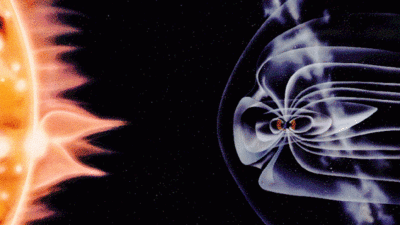Solar wind
--Cradford6 (talk) 19:34, 4 December 2015 (EST)--Cradford6 (talk) 18:58, 4 December 2015 (EST)Caelan Radford
The solar wind is a phenomena created by charged particles ejected by the Sun. It is mainly consisted of particles including electrons, protons, and alpha particles (helium nuclei). The constant stream of particles can reach speeds up to millions of miles per hour and make up the make up the medium of the solar system. The solar wind radiates outward from the sun until a radius where the force exerted by the solar wind equals the force exerted by the interstellar medium. This radius is the heliopause, the outer edge of the Solar System.
Cause
Solar wind is created by complex electromagnetic forces in the atmosphere of the Sun. The outer region of the Sun's atmosphere, the corona, is the source of the solar wind. The source of the force propelling the solar wind is a modern mystery; the thermal energy of the corona is not large enough to account for the speed of the particles (even though the corona is around a million degrees Celsius). It is hypothesized that the force must be a powerful magnetic force, but the source and mechanism of the force is not well understood.
Interactions
With Magnetospheres
The most relevant interaction to us on Earth is the interaction of the solar wind with magnetospheres. A magnetosphere is the region of space surrounding an object where the dominant magnetic field is the field produced by that object. The Earth produces a magnetosphere with a field similar to a bar magnet. Through a complex interaction, the solar wind "carries" some of the Sun's magnetic field with it. When it arrives at Earth, both the energy of the particles and magnetic field bombard the magnetic field of the Earth, and change its shape.

The particles of the solar wind are deflected by the magnetic field of the Earth due to the Lorentz force. The magnetic field of the Earth also traps some of the particles in orbits called 'radiation belts.' Satellites with orbits through these regions must have additional shielding against radiation. Some particles of the solar wind still leak into the magnetosphere, especially when solar storms or mass coronal ejections increase the speed or quantity of the solar wind. When they do, different phenomena related to electricity and magnetism occur. One of such phenomena is the 'Aurora borealis,' or the Northern Lights. This bright display is caused when charged particles enter the atmosphere at certain regions and ionize other atoms. Another result of increased solar activity is geomagnetic storms. Geomagnetic storms refer to the ability of strong solar winds to cause changes in the Earth's magnetic field. At a basic level, the cause of the 'storm' is the changing magnetic field of the Earth, which creates additional electromagnetic forces. These forces are strong enough to disrupt GPS signals, create measurable forces on satellites, and induce currents in power grids, causing damage.
Other Objects
If an object in the Solar System is not protected by a strong magnetic field, it is bombarded by the solar wind. This force is the cause of the visible tails on comets. The solar wind is bombarding the comet and transferring energy to small particles, which creates a tail on the comet that always points away from the sun. Other larger objects are affected as well. Mars, for example, has a relatively weak magnetosphere due to an apparent lack of a liquid core. Because of this, the solar wind bombards Mars and transfers energy to atoms in its atmosphere, driving them into space. NASA's Mars Atmosphere and Volatile Evolution mission has shown Mars loses more mass from its atmosphere during solar storms, suggesting the solar wind had a large role in changing the atmosphere of Mars to what it is today. Manmade objects are subject to the solar wind as well. Satellites must be able to withstand the radiation. There have also been many proposed designs for spacecraft with 'sails' which take advantage of the energy of solar wind either using electric or magnetic fields to capture the particles and 'steal' their energy.
Connectedness
- How is this topic connected to something that you are interested in?
The topic is interesting because it shows a way electromagnetic forces can allow something as distant as the Sun to have a huge affect on Earth. It is also interesting to see how simple concepts such as the Lorentz force and Faraday's law can be shown to be the cause of macroscopic phenomena.
- How is it connected to your major?
As a biology major, the idea that life on Earth is protected by its magnetic field is fascinating. It has implications about rarity of life and requirements for its formation.
- Is there an interesting industrial application?
Solar wind could theoretically be harnessed as a power source for spacecraft. The technology seems far fetched, but there are several projects working on making these types of 'sails' become a reality.
History
In the time between now and when physicists thought there was an 'ether' that filled space, it was assumed that space was a vacuum. Some scientists had connected changes in Earth's magnetic field with solar activity, but it wasn't until 1958 that Eugene Parker suggested the Sun was allowing charged particles to escape its corona and produce the solar wind, which fills the solar system. At first there was opposition to the idea, but it was generally accepted when measurements of the solar wind were made by Soviet spacecraft shortly after.
See also
References
http://solarscience.msfc.nasa.gov/SolarWind.shtml
http://www.swpc.noaa.gov/phenomena/solar-wind
http://www.brighthub.com/science/space/articles/83552.aspx
http://www.swpc.noaa.gov/phenomena/geomagnetic-storms
http://www.swpc.noaa.gov/phenomena/earths-magnetosphere
http://pluto.space.swri.edu/image/glossary/IMF.html
http://nmp.jpl.nasa.gov/st5/SCIENCE/magnetosphere2.html
http://www.northernlightscentre.ca/northernlights.html
http://news.nationalgeographic.com/news/2003/08/0827_030827_kyotoprizeparker.html